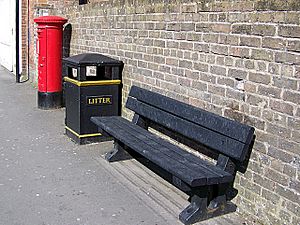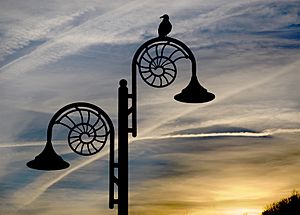Street furniture facts for kids


Street furniture includes all the objects placed on streets and roads in towns and cities. These items are there to help people, keep them safe, and make public spaces more useful and enjoyable. You can find street furniture in many places, especially in countries like the UK, Canada, and Australia.
Think about all the things you see when you walk down a street. Street furniture includes things like benches where you can rest, bollards that stop cars from going into pedestrian areas, and post boxes for sending letters. It also covers phone boxes, street lighting to make areas bright at night, and traffic lights and traffic signs to control vehicles and pedestrians.
Other common examples are bus stops and tram stops, which help people wait for public transport. You might also see grit bins (for spreading salt in winter), taxi stands, public toilets, fountains, and memorials. Even waste receptacles (bins) are considered street furniture.
One very important part of designing street furniture is making sure it helps with road safety. This means placing items so they don't block views or create hazards for people walking, cycling, or driving. Good design helps everyone move around safely.
Contents
Types of Street Furniture
Street furniture comes in many different types, each with a special job. They help make our towns and cities work better for everyone.
For Resting and Socializing
- Benches: These are for people to sit and rest, often found in parks, bus stops, or shopping areas.
- Picnic tables: Sometimes found in public parks, they offer a place for families and friends to eat outdoors.
For Guiding and Safety
- Traffic lights: These control the flow of cars and pedestrians at intersections, making sure everyone can cross safely.
- Traffic signs: They give important information to drivers and walkers, like speed limits, directions, or warnings.
- Bollards: Strong posts that block vehicles from entering certain areas, often used to protect pedestrians.
- Street lighting: Lamps that light up streets and sidewalks at night, improving safety and visibility.
For Communication and Services
- Post boxes: Places where you can drop off letters to be mailed.
- Phone boxes: Although less common now, these used to be important for making public phone calls.
- Bus and tram stops: Shelters and signs that mark where public transport picks up and drops off passengers.
- Public toilets: Facilities for people to use when they are out and about.
For Cleanliness and Environment
- Waste receptacles: Bins for throwing away rubbish, helping to keep streets clean.
- Grit bins: Containers holding salt or grit, used to make icy roads and paths safer in winter.
- Fountains: Often decorative, but some also provide drinking water.
Design and Importance
The way street furniture looks and where it is placed is very important. Designers think about how these items will fit into the area. They consider things like the style of nearby buildings, the history of the place, and how people will use the space.
Good design means that street furniture is:
- Useful: It serves its purpose well, like a bench that's comfortable to sit on.
- Safe: It doesn't create dangers for people, like a lamp post that's easy to see.
- Durable: It can last a long time in all kinds of weather.
- Attractive: It looks good and adds to the beauty of the street.
Street furniture helps make public spaces more welcoming and functional. It plays a big role in how we experience our towns and cities every day.
Related pages
Images for kids
-
The signage systems of Metz, France, were created by Swiss designer Ruedi Baur.
-
Fire hydrant in Prague
-
Sidewalk valve for long defunct gas lighting company, Uptown New Orleans.
See also
 In Spanish: Mobiliario urbano para niños
In Spanish: Mobiliario urbano para niños





